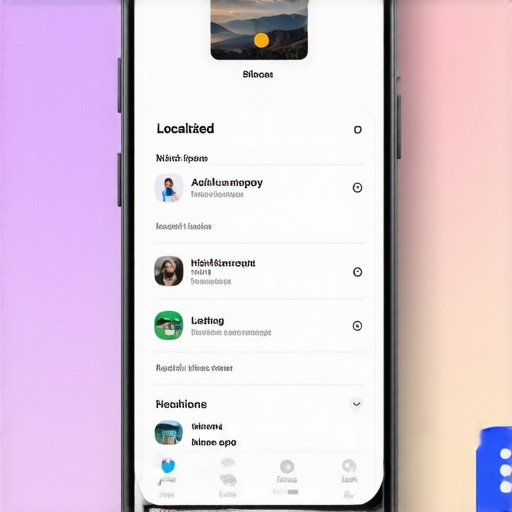My First Encounter with Click-Through Rate Challenges
Honestly, I remember the day I realized that even with perfect keywords, my local business wasn’t ranking as high as I wanted. It was frustrating to see competitors outranking me despite similar SEO efforts. That’s when I decided to dive deep into CTR optimization strategies, and my journey truly began.
Understanding the Power of CTR in Local Search
Through my research and experience, I discovered that click-through rates directly influence local rankings. Google interprets a high CTR as a sign of relevance and engagement. It’s fascinating how small tweaks to your snippets can make a significant difference. For example, adding compelling call-to-actions or local emojis can boost your attractiveness in search results.
Practical Techniques I Used to Boost Engagement
I experimented with several tactics, such as optimizing meta descriptions to be more enticing and localized, including relevant LSI keywords naturally. I also made sure my business’s NAP (Name, Address, Phone Number) was consistent across all platforms, which Moz highlights as vital for local SEO.
How Can You Effectively Optimize Your CTR?
What are the most overlooked elements that can skyrocket local CTR?
From my perspective, one often-overlooked factor is the use of structured data markup. Implementing schema can enhance your search snippets with rich information like reviews, ratings, and availability, making your listing more attractive. I recommend checking out Schema.org for comprehensive guidelines.
If you’re serious about local success, I invite you to share your experiences or ask questions below. Connecting with others on this journey can provide fresh insights and motivation.
Final Thoughts: The Continuous Journey of CTR Optimization
Optimizing for Google engagement is not a one-time task but an ongoing process. By consistently testing and refining your snippets and engagement signals, you can elevate your local rankings. Remember, the key is genuine relevance and user-centric strategies. For more advanced tactics, I recommend exploring this comprehensive guide.
Uncovering Hidden Factors That Drive Local CTR and Engagement
While optimizing meta descriptions and leveraging schema markup are proven tactics, there’s a nuanced layer that often escapes standard SEO practices—psychological triggers that influence user behavior. Incorporating scarcity, urgency, and social proof into your snippets can significantly enhance your click-through rate. For example, phrases like “Limited Offer” or “Serving Your Area for Over 10 Years” tap into user psychology, prompting quicker decisions.
The Role of Visual Elements and Local Emojis in Search Results
Visual cues are powerful. Incorporating relevant emojis and icons into your snippets can make your listing stand out amidst a sea of competitors. According to a study by Neil Patel, emojis can boost engagement by up to 25%. Additionally, using images and rich snippets—like menus, reviews, or event info—can further entice clicks, especially when optimized with schema markup.
![]()
 Alt text: A search engine results page showing enhanced snippets with icons and reviews.
How Does User Intent Shape Your CTR Optimization?
Understanding the nuances of user intent is crucial. Are searchers looking for immediate services, informational content, or local reviews? Tailoring your snippets to address these specific intents can drastically improve relevance, thereby increasing CTR. For instance, including keywords like “24-hour emergency plumber in Brooklyn” directly aligns with transactional intent, making your listing more appealing. For deeper insights, explore this data-driven approach to engagement signals.
What innovative tactics can help outsmart competitors in crowded local searches?
One cutting-edge strategy involves A/B testing different call-to-actions within your snippets—testing phrases like “Call Now,” “Get a Free Quote,” or “Book Today”. Using tools like Google Search Console alerts you to which variants perform best. Additionally, integrating localized reviews and Q&A snippets can build trust and relevance, further boosting your CTR. Remember, continuous testing and refinement are essential in maintaining a competitive edge.
If you’re eager to elevate your local search presence further, I recommend reading more about advanced CTR strategies and engagement signals at this resource. And don’t forget—sharing your experiences or asking questions below can spark valuable discussions and insights.
Unveiling the Psychological Triggers Behind Clicks
Over the years, I’ve learned that understanding user psychology can dramatically influence your CTR. Beyond straightforward optimization, tapping into emotions like scarcity and social proof can make your snippets irresistible. For example, phrases like “Only a Few Spots Left” or “Trusted by Over 500 Local Customers” can create urgency and build trust simultaneously. These subtle cues leverage innate human tendencies—our desire to avoid missing out and our reliance on peer validation—leading to higher engagement and more clicks.
The Power of Visual Elements and Emojis in Search Results
In my experience, visual cues are often underestimated in local SEO. Incorporating relevant emojis or icons within your titles and descriptions can make your listing stand out, especially on mobile devices where visual distinction matters. Neil Patel’s research confirms that emojis can boost engagement by up to 25%, but the key is relevance and moderation. For instance, using a 📞 next to your contact info or a 🚗 for local transportation services enhances clarity and appeal. Rich snippets, like reviews or event info, further draw attention and improve CTR when optimized with schema markup.

 Alt text: Search engine results page showcasing enhanced snippets with icons and reviews.
Deepening CTR Optimization: Addressing User Intent with Precision
Understanding the specifics of what your audience seeks is fundamental. Are they looking for immediate services, seeking informational content, or researching reviews? Tailoring your snippets with targeted keywords—like “Emergency Plumber in Brooklyn Open Now”—aligns with transactional intent, making your listing more relevant. I found that detailed, intent-specific descriptions resonate better and increase CTR. For further insights, check out this data-driven approach, which emphasizes matching content to user needs.
How Can Continuous Testing Transform Your Local SEO Results?
In my journey, I discovered that A/B testing different call-to-action phrases—like “Call Now,” “Get Your Free Quote,” or “Schedule Today”—can provide valuable insights into what resonates with your local audience. Using tools such as Google Search Console alerts you to which variants perform best, allowing for iterative improvement. Additionally, integrating localized reviews and Q&A snippets can foster trust and relevance, leading to sustained CTR growth. Remember, ongoing experimentation is key to staying ahead in competitive local searches.
If you’re eager to elevate your local SEO game, I encourage you to explore this comprehensive guide. And I invite you to share your own experiences or ask questions in the comments—collaborative learning fuels better results.
Refining Your Schema Markup for Maximum Visual Impact
One of the subtler yet profoundly effective tactics I’ve employed involves meticulously customizing schema markup to generate richer, more enticing search snippets. Beyond basic reviews and ratings, implementing structured data that highlights specific services, product availability, or event details can transform your listing into a mini-landing page directly within search results. This approach not only boosts CTR but also signals to Google that your content is highly relevant and user-focused. I recommend exploring Schema.org for advanced markup options tailored for local businesses.
How Do Psychological Framing Techniques Elevate User Engagement?
Throughout my career, I’ve observed that framing your snippets with strategic psychological cues—such as emphasizing exclusivity or demonstrating social proof—can dramatically increase engagement. Phrases like “Join Over 1,000 Happy Locals” or “Limited-Time Offer for Our Community” tap into innate human tendencies toward FOMO (fear of missing out) and trust. Incorporating these into your meta descriptions and titles can subtly influence user behavior, making your listing irresistibly clickable. For a comprehensive understanding of these tactics, I recommend reviewing Neil Patel’s insights on psychological triggers.
Can Advanced A/B Testing and Personalization Drive Long-Term CTR Growth?
Yes, and in my experience, ongoing, granular testing—especially when combined with local audience insights—can unlock substantial gains. Instead of generic CTAs, customizing calls-to-action based on neighborhood demographics, seasonal trends, or even time-of-day can yield higher engagement. Tools like Google Optimize or Hotjar facilitate these experiments, enabling you to refine your snippets iteratively. Moreover, integrating user-generated content, such as reviews or Q&A snippets, personalized to specific localities, can foster a deeper connection and trust with your audience. This level of personalization turns standard CTR optimization into a strategic, long-term growth engine. For more detailed tactics, I encourage you to explore this data-driven approach.
What Is the Impact of Mobile-First Optimization on Local CTR?
Given that a significant portion of local searches happen on mobile devices, optimizing for mobile-first experiences is crucial. Fast-loading pages, touch-friendly interfaces, and mobile-optimized snippets with clear, concise information can significantly influence click behavior. Incorporating mobile-specific schema, such as click-to-call buttons and location maps, enhances the user experience and increases the likelihood of engagement. Moreover, aligning your visual and textual cues for mobile viewing—like using emojis and localized keywords—ensures your listing stands out on small screens. To stay ahead, I advise reviewing Google’s Mobile-First Indexing guidelines and continuously testing your mobile snippets for maximum impact.

 Alt text: Mobile search results page showcasing enhanced snippets with localized icons and calls-to-action.
Things I Wish I Knew Earlier (or You Might Find Surprising)
The Hidden Power of Psychological Triggers
One thing I learned the hard way is that understanding user psychology can dramatically influence your CTR. Subtle cues like scarcity or social proof—think phrases like “Limited Offer” or “Trusted by Over 500 Local Customers”—can make your snippets irresistibly clickable. Incorporating these elements into your meta descriptions can turn casual browsers into engaged customers.
The Impact of Visual Elements and Emojis
In my experience, visual cues are often underestimated. Adding relevant emojis or icons within your snippets can help your listing stand out, especially on mobile devices. Neil Patel’s research shows emojis can boost engagement by up to 25%. Simple touches like a 📞 next to your contact info or a 🚗 for transportation services can make a real difference.
Why Continuous Testing Matters
Instead of a set-it-and-forget-it mindset, I found that regular A/B testing of your snippets—trying different calls-to-action like “Call Now” vs. “Get a Free Quote”—can lead to steady improvements. Using tools like Google Search Console helps track what resonates best with your local audience, ensuring your strategies stay fresh and effective.
Deepening Your Schema Markup
Beyond basic reviews, customizing schema markup to highlight specific services or events can transform your search snippets into mini-landing pages. This not only increases CTR but also signals to Google that your content is highly relevant. I highly recommend exploring Schema.org for advanced options.
The Role of Mobile-First Optimization
With most local searches happening on mobile, optimizing your snippets for mobile is a must. Fast-loading pages, touch-friendly design, and mobile-specific schema—like click-to-call buttons—can significantly influence whether users click on your listing. Google’s Mobile-First Indexing guidelines are a great resource to keep in mind.
Resources I’ve Come to Trust Over Time
- Google’s Search Central Blog: An essential resource for updates on mobile-first indexing and best practices directly from Google.
- Neil Patel’s Blog: Offers practical insights on emojis, psychological triggers, and content optimization—recommended for anyone looking to boost engagement.
- Schema.org: The go-to source for implementing structured data that can enhance your search snippets.
- Moz’s Local SEO Guide: Provides thorough strategies on local rankings and engagement signals that helped me refine my approach.
Parting Thoughts from My Perspective
From my experience, the real secret to local SEO success lies in understanding your audience and continuously refining your approach. CTR optimization isn’t a one-off task but an ongoing journey of testing, learning, and adapting. Incorporate psychological cues, visual elements, and mobile-first strategies, and you’ll see your local rankings improve steadily. If this resonates with you, I’d love to hear your thoughts—feel free to share your experiences or ask questions below. Remember, the key to thriving in local search is genuine relevance and user-centric strategies.


This post resonates with my own experience, especially the part about psychological triggers like scarcity and social proof. I’ve found that incorporating phrases such as ‘Limited Time Offer’ or displaying reviews with star ratings directly in snippets can really boost user engagement. I also started experimenting with emojis in my local listings, like 📞 for contact links and 🚗 for transportation services, which Neil Patel highlights as effective. While I’ve seen a noticeable uptick in CTR, I still wonder, how do you balance eye-catching snippets with maintaining professionalism? Has anyone here used schema markup to enhance rich snippets and found it significantly impactful in local SEO results? Would love to hear real-world successes or challenges others have faced with structured data in their strategies.